The Canon 7D Mark II is going to sit on the APS-C throne for Canon over next few years. It has been a hot topic of discussion since it was first announced and initial impressions of the camera have been very positive.
I have used the camera for a couple of months and have been very impressed with most aspects of the camera. While there is no one feature that is a “Wow!” factor when you look at the Canon 7D Mark II’s spec sheet, all of the little things start to add up for a solid-performing camera born from the pedigree of the original Canon 7D.
Canon 7D Mark II Key Features
- 20.2MP APS-C CMOS Sensor
- Dual DIGIC 6 Image Processors
- 3.0″ 1.04m-Dot Clear View II LCD Monitor
- 100% View, 1x Magnification Intelligent Viewfinder II
- 1080p/60 Video Capture
- CF (UDMA 7) and SD/SDHC/SDXC (UHS-I) Memory Card Slots
- Dual Pixel CMOS AF with Live View
- 65-Point All Cross-Type Phase-Detect AF
- ISO 100-16000 (expansion to ISO 51200)
- 10 fps Continuous Shooting
- Built-In GPS Receiver & Digital Compass
- Magnesium Alloy Body Construction
- Shutter Rated for 200,000 Cycles
- Built-in Intervalometer
Building on a Solid Foundation
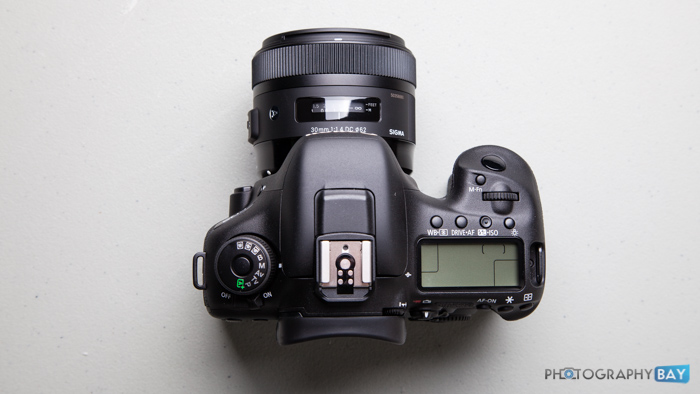
Over the years, Canon seemed to grow increasingly conservative in the delivery of new products and did very little to impress any of us with outlandish specifications and features. The 7D Mark II continues that trend at first blush.
However, once you start to dig into the camera and use it, you begin to peel back layer after layer of new and improved features and functionality that demonstrate just how serious of a camera the 7D Mark II wants to be. The original Canon 7D filled a niche as a prosumer-grade sports and action camera with some interesting new features like linking AF-points to camera orientation. The video features of the original 7D were also improved over the 5D Mark II with a more thought-out feature set from the launch.
The 7D Mark II takes these features from its predecessor and dials them up a notch, along with improving an already-solid AF system and significantly better image quality.
Canon 7D Mark II Stand-Out Features
I’m not going to run down the entire spec sheet of the 7D Mark II; however, there are several important features on the 7D Mark II that work together to produce a solid camera system.
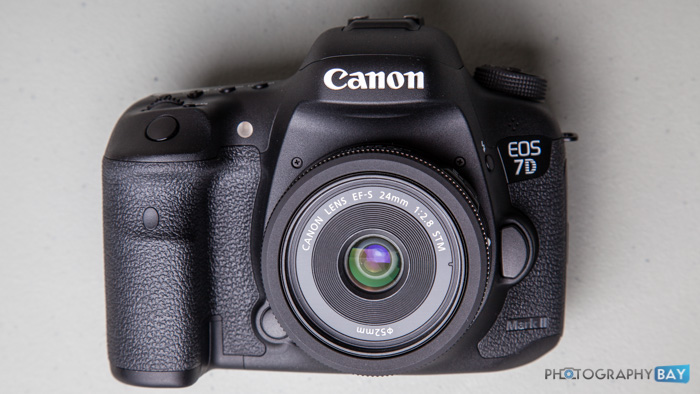
10fps Frame Rate & Improved Shutter
While the 7D delivered an impressive 8fps, the 7D Mark II dials that up to 10fps with AF tracking for a true sports shooter’s camera. Additionally, the 7D Mark II offers an improved shutter life rating up to 200,000 actuations – up from 150,000 on the original.
New 20.2MP APS-C CMOS Sensor with Dual Pixel AF
The new 20.2MP sensor in the 7D Mark II delivers impressive image quality, particularly for an APS-C sensor. It is an obvious jump in quality compared to the 18MP sensor in the original 7D. The difference in quality are apparent in low-light and high ISO images. I don’t have direct comparisons with the 7D; however, I shot many frames with the 7D and feel that the dynamic range is also improved.
Overall, I am please with the jump in image quality from the prior generation. It is not groundbreaking; however, it is significant enough to be a stand-out feature for this upgrade.
The addition of the Dual Pixel AF to the 7D Mark II makes it probably the most formidable Canon HDSLR on the market (aside from the $8k Canon 1D C). Dual Pixel AF worked great on the Canon 70D and it performs just as well on the 7D Mark II. The only thing I missed is the touchscreen AF point selection on the 70D. After using the 70D and being able to tap my focus point on the screen while shooting, I want it on every HDSLR from here on out.
Professional Grade AF System
The original Canon 7D had a great AF system with some solid features to enable better AF tracking than what we had seen in prior Canon DSLRs in this price range. However, Canon took the technology from its $6000 1D X sports shooter and built the even more impressive AF system inside the 7D Mark II.
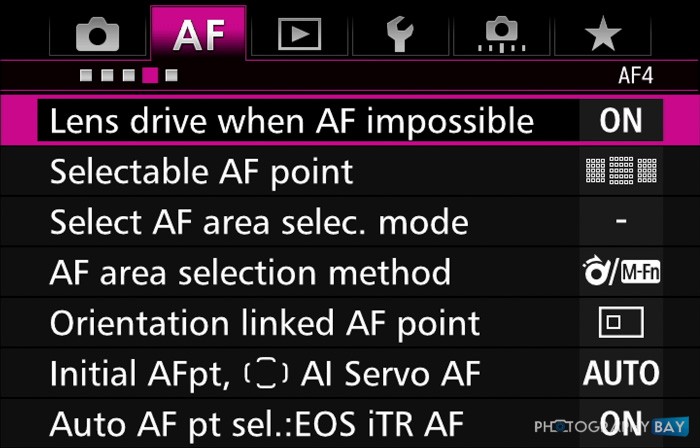
The 7D Mark II offers 65 AF points and each AF point is a cross-type AF point with lenses that are f/5.6 or faster. The center AF point is a diagonal cross-type AF point with f/2.8 or faster lenses. Additionally, the center AF point will continue to work with extenders when the effective max aperture of lenses is f/8.
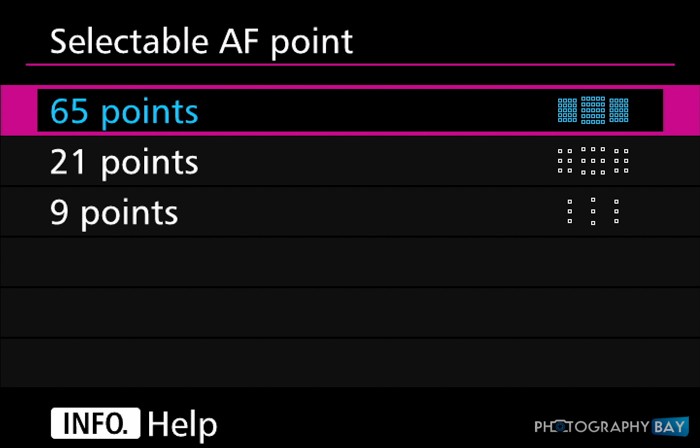
Given the vast number of AF points available, you can choose to make all 65 points selectable or choose a more reasonable option of 21 AF points or 9 AF points available for manual selection.
Additionally, there are seven different AF Area Selection modes available. These different modes let you choose among the different sizes of AF areas from which to pull focusing information.
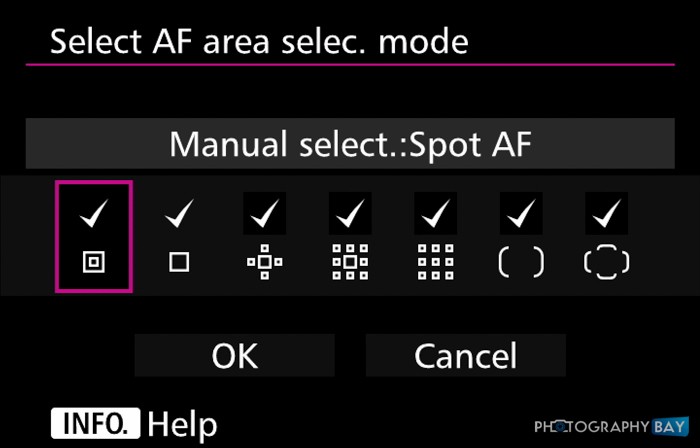
The AF Area Selection modes (shown left to right in above menu) include:
- Single-point spot AF
- Single-point AF
- AF point expansion (4 surrounding points)
- AF point expansion (8 surrounding points)
- Zone AF
- Large Zone AF
- 65-point automatic selection
You can pretty much go down the list to choose from still subjects for fine detail to the fastest and most erratic subjects for AF tracking in terms of you needs. In the 65-point full auto mode, you select the starting AF point to begin tracking the subject and the camera takes over from there by using the 150,000-pixel RGB+IR metering system to identify the color, size and shape of the subject and track it across all 65-points.
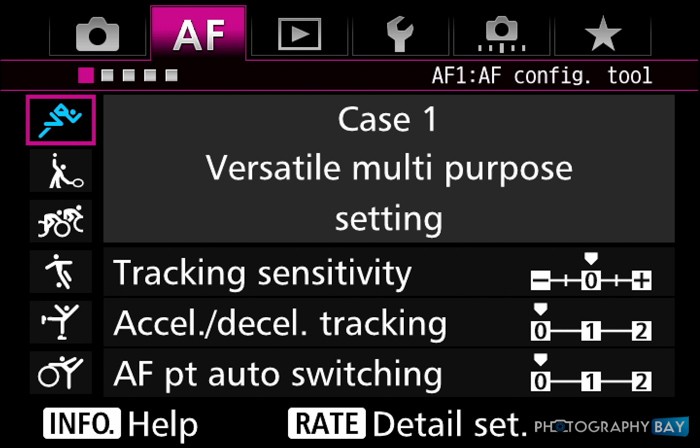
There are six base presets for continuous AF tracking that all have different sensitivity, tracking and AF point switching parameters. Each of these can be selected in the first sub-menu of the AF tab within the menu. All of these presets can be further refined to fit the particular user’s needs.
The tracking sensitivity adjustment allows you to change the AF response time when a subject that is in focus moves out of the AF points in AI servo mode. A negative value keeps the subject in focus even if they briefly leave the AF points. The lower the value, the longer the same subject is tracked even if they leave the active AF points. Positive values means the AF system is quicker to switch focus to a new subject that enters the active AF points.
So you can imagine the different sports and wildlife applications where these settings fit different scenarios. Think single-subject sports and wildlife versus team sports.
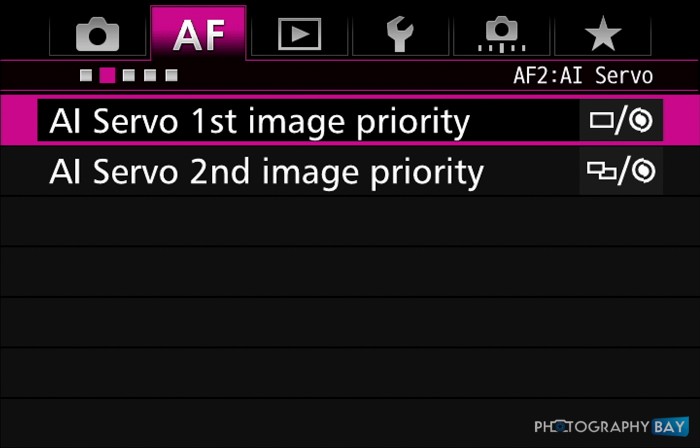
Moving on in the AF menu tab, you also have the ability to choose the AF priority in AI servo mode for first and second image shutter release.
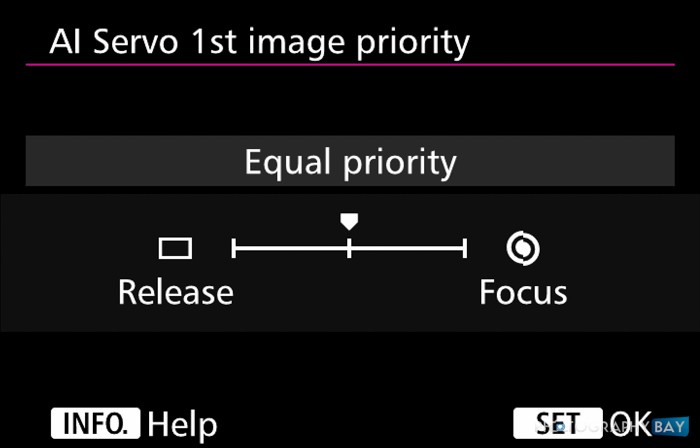
You can choose to give priority to obtaining focus or releasing the shutter faster. Likewise, for subsequent frames, you can prioritize frame rate speed over focus tracking and vice versa. 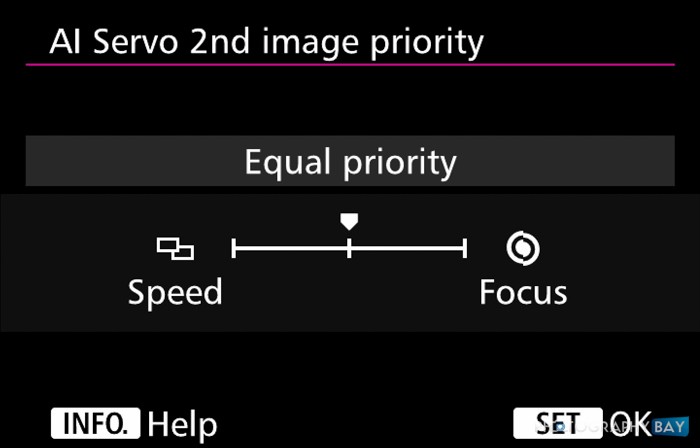
Obviously, if you favor focus too much and the camera has to do some heavy lifting in tracking, you are going to lose some pop off of that 10fps frame rate. Likewise, put too much emphasis on speed and you’ll end up with blurry shots if the camera is trying to maintain tracking on a fast moving subject. These are options more commonly reserved for DSLRs that cost thousands more than the 7D Mark II.
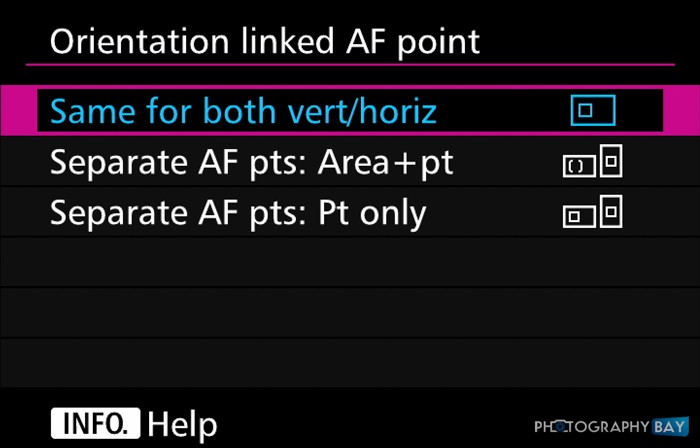
The 7D Mark II also continues the awesome Orientation Linked AF found in the original Canon 7D. This system allows you to set default AF points based on the camera’s horizontal or vertical framing orientation. This is a time and shot saver when switching orientations so that you don’t have to switch AF points manually.
While I did not shoot any sporting events, I tried on a couple occasions to get the 7D Mark II to fail in AF tracking but it refused to give up.
As an example, I shot a several series of cars approaching me on the highway around 40mph or so and the 7D Mark II tracked them at this closing speed from around 200 feet away to with 20-30 feet with very few failures.
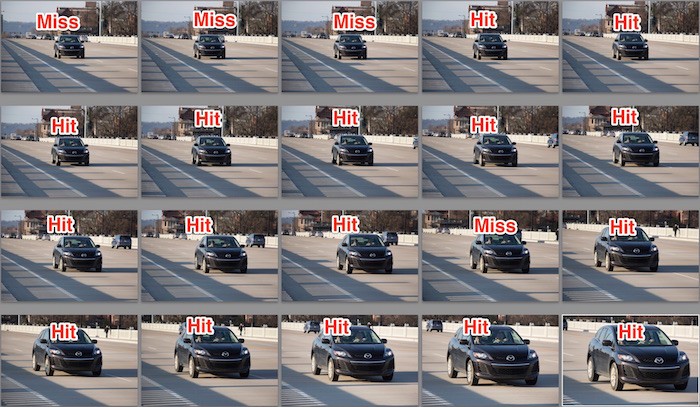
7D Mark II AF Tracking Series
Most of the dropped focus shots occurred at the beginning of the series when I did not allow that camera to track with AF on and simply pressed the shutter to start the burst. This is pretty common among all continuous tracking systems. You really should give it a second or so of tracking opportunity to lock onto the subject. Regardless, after a dropped shot or two, the 7D Mark II would track and nail focus on the next 15 or so shots with few misses in between.
Also note in the above example that the miss during the middle of the continuous AF burst comes after a slight reframing, which could very well be the cause of the miss as the AF system adjusts the focus point for further tracking. Additionally, these AF tracking tests were performed with the consumer-grade EF-S 18-135mm IS STM kit lens.
As noted above, the 7D Mark II’s AF system is professional grade. It delivers plenty of options and performance for the most demanding professionals. There is really nothing to criticize about the AF system of this camera. If you own a 7D Mark II or you are going to buy one, I highly recommend reading the official 7D Mark I AF-Setting Guidebook, which will walk you through the many, many features and settings for just the AF system.
Intervalometer
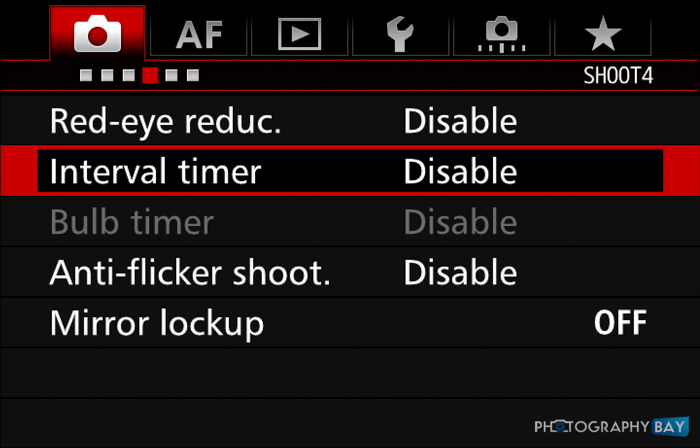
Finally!
It took Canon long enough, but we finally got an intervalometer in a Canon DSLR. It works and it works well. Watch the above video to see how you can use the built-in intervalometer to capture images for timelapse video.
1080/60p Video and Clean HDMI Output
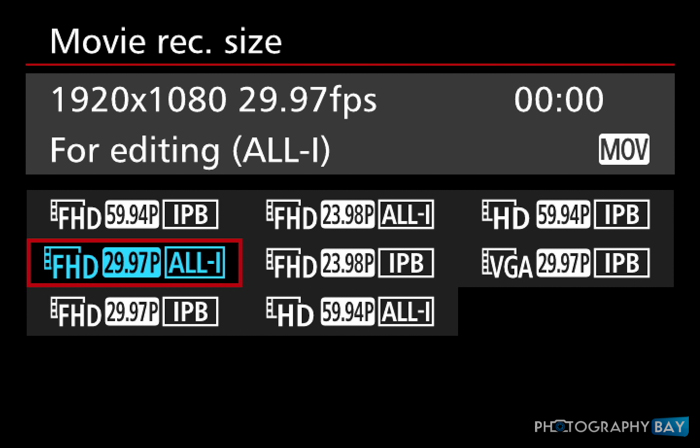
The 7D Mark II steps up video capture to 60 frames per second at 1080p resolution. Files can be recorded internally to CF or SD cards in ALL-I or IPB formats. Additionally, the 7D Mark II offers clean HDMI-output for recording to an external recorder such as the Atomos Ninja 2 or Ninja Blade.
Along with video capture format and HDMI improvements, it is worth mentioning again the effectiveness of the Dual Pixel AF and Movie Servo AF, which allows for smooth focusing that is on par with what you would expect from a consumer camcorder. However, the Movie Servo AF adds the ability make smooth focus adjustments while recording for a more professional look and feel.
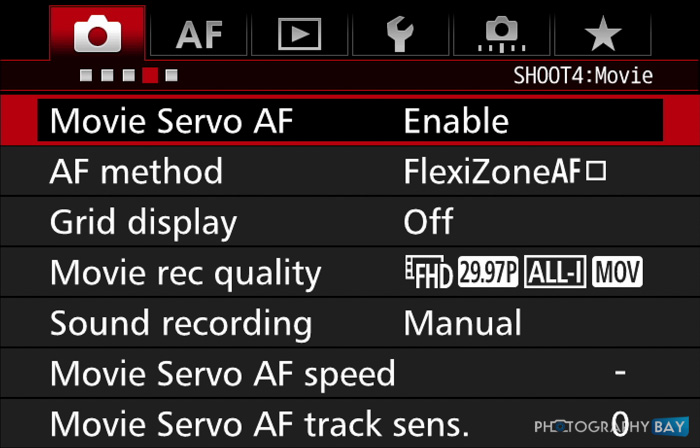
Additionally, it makes still image lenses more useful. Even if you are not adjusting focus during a shot, the ability to zoom in on the frame and nail focus on any eye with live view and the Dual Pixel AF is a time saver over the old method of manually hunting with a still image lens’ short focus through. The accuracy of the 7D Mark II’s live view focusing gives confidence that static video frames will be in focus.
ISO 100-16000
The 7D Mark II sensitivity ranges from ISO 100-16000. Additionally, that can be expanded up to ISO 51200 for additional reach; however, the performance fall-off is probably not worth it in all but the most extreme cases.
What the 7D Mark II does from ISO 100-16000 is impressive. It delivers solid performance through this native ISO range.

Below is a range of images featuring the same scene captured with the 7D Mark II and the 5D Mark II throughout the ISO range of both cameras. I have combined 100% crops of the above scene to compare the noise and dynamic range throughout the sensitivity range of the cameras.

These images were not captured with the same lens. The 5D Mark II had an L lens attached, while the 7D Mark II has its kit lens attached. As a result, don’t judge some of the edge softness you see from the 7D Mark II 100% crops against the camera itself.
While the Canon 5D Mark III would easily best the 7D Mark II’s noise performance, it is nice to see that it holds up well against the 5D Mark II. While a much older camera, the 5D Mark II still delivers solid images with its excellent full frame sensor. Combine that image quality with the performance of the 7D Mark II in every other aspect and you have a very competent camera.
7D Mark II Lens Choices
While testing the Canon 7D Mark II, I primarily used three lenses that are specifically designed for the APS-C sensor: the Sigma 30mm f/1.4 DC HSM Art lens, the Canon EF-S 24mm f/2.8 STM lens and the Canon EF-S 18-135mm f/3.5-5.6 IS STM lens. I also, at times, used the EF 50mm f/1.4 USM, EF 24-105mm f/4L IS USM and Sigma 70-200mm f/2.8 DG HSM lenses.
All of these lenses performed well, however, I have some comments about each of the three APS-C lenses on the 7D Mark II.
Sigma 30mm f/1.4 DC HSM Art Lens
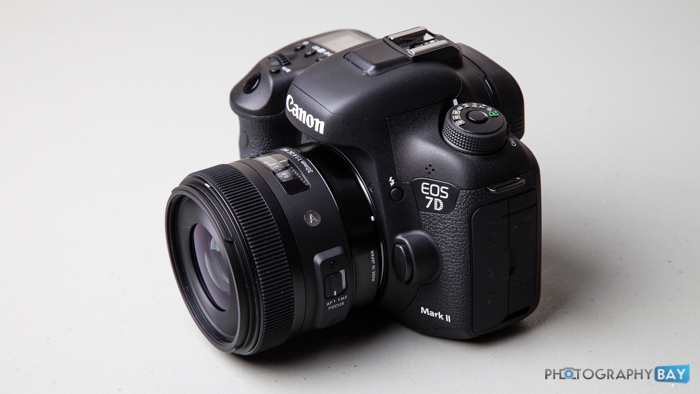
The Sigma 30mm f/1.4 lens is a great companion for the 7D Mark II (or other APS-C cameras for that matter). I really had a hard time taking this lens off the camera as a daily walk-around lens.
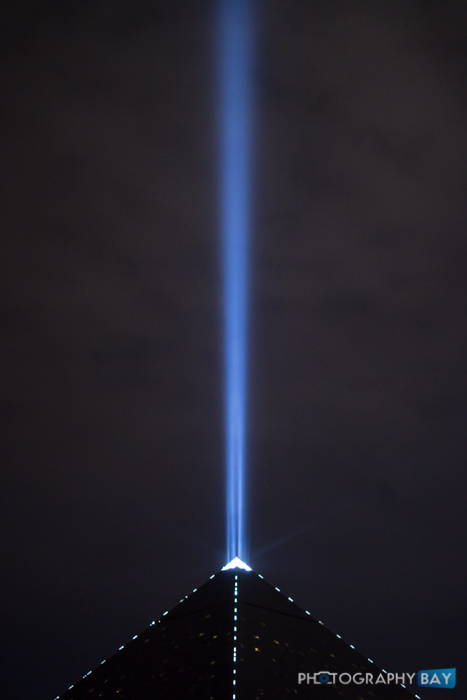
Shot with Sigma 30mm f/1.4
It produces sharp images and has a very fast aperture with a normal field of view when considering the crop factor of the 7D Mark II (about 48mm equivalent).
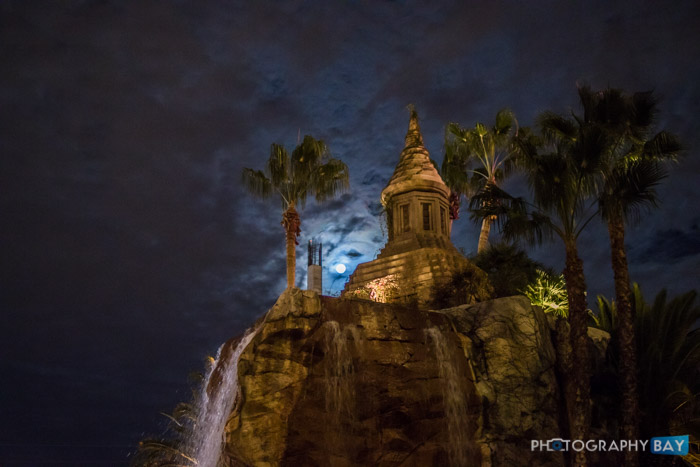
Shot with Sigma 30mm f/1.4
Focus is fast and accurate thanks to the HSM motor on the Sigma lens. It offers a reasonably close minimum focusing distance of 30cm, or about one foot. The lens is made up of nine elements in eight groups and has a nine blade diaphragm, which produces pleasing circular bokeh.
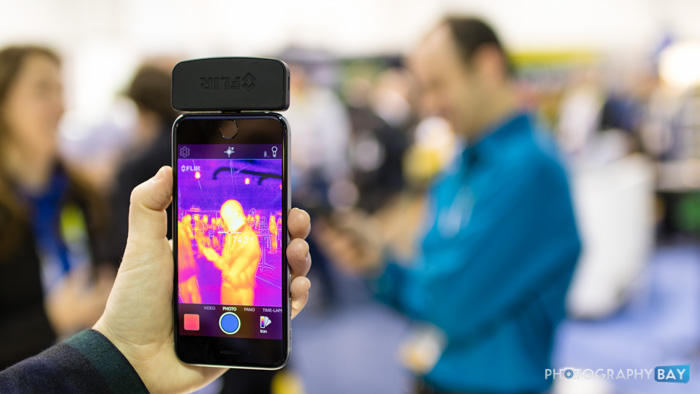
Shot with Sigma 30mm f/1.4
My only real objection to the Sigma 30mm f/1.4 is that it seems to have a little more noticeable purple fringing occurring around high contrast points.
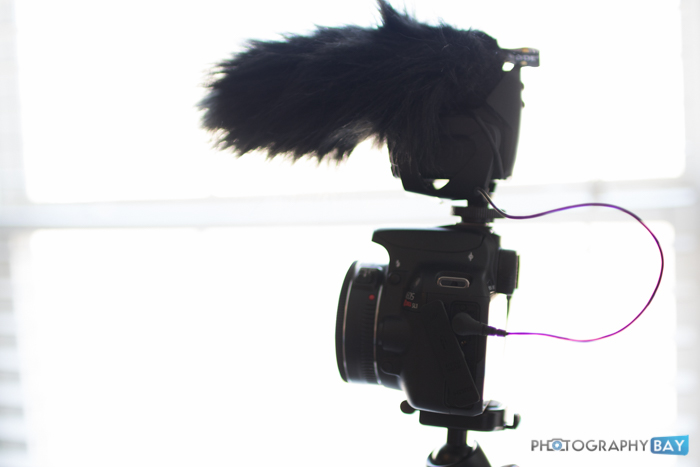
Shot with Sigma 30mm f/1.4
It is obviously the worst wide open, which you can see in above image, and more clearly in the 100% crop samples below.
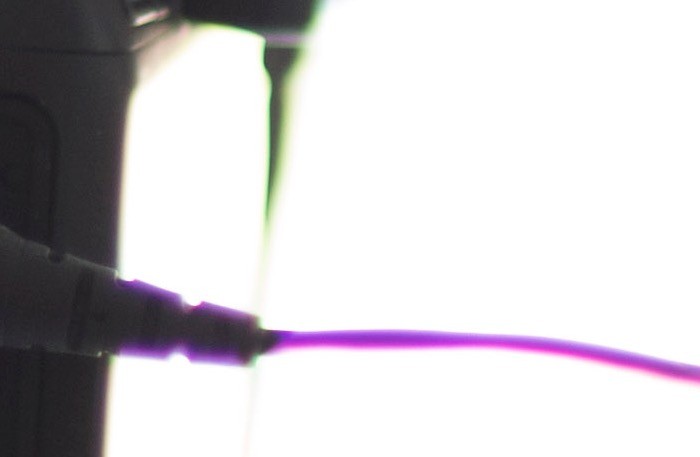
Sigma 30mm at f/1.4
I noticed when using the Sigma 30mm f/1.4 lens in low light situations at CES 2015 that it was more apparent than what I am accustomed to shooting wide open.
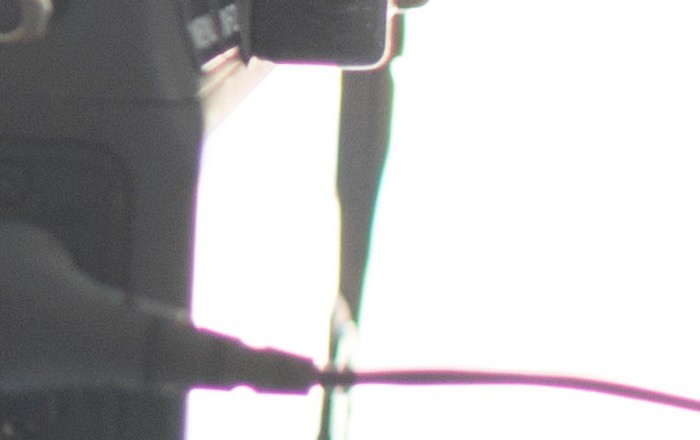
Sigma 30mm at f/2.8
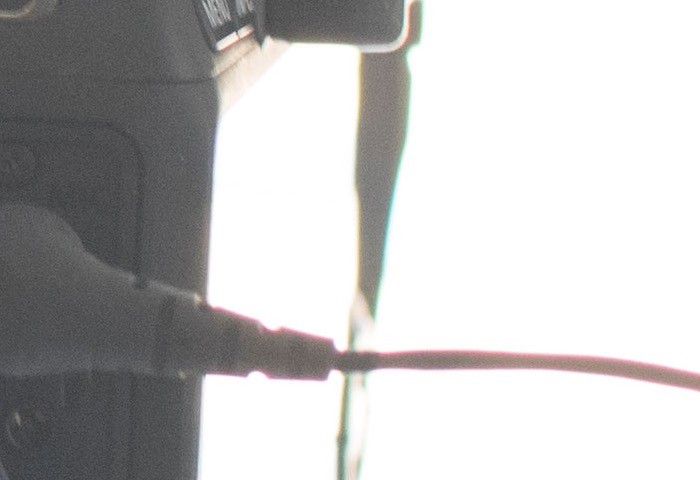
Sigma 30mm at f/4
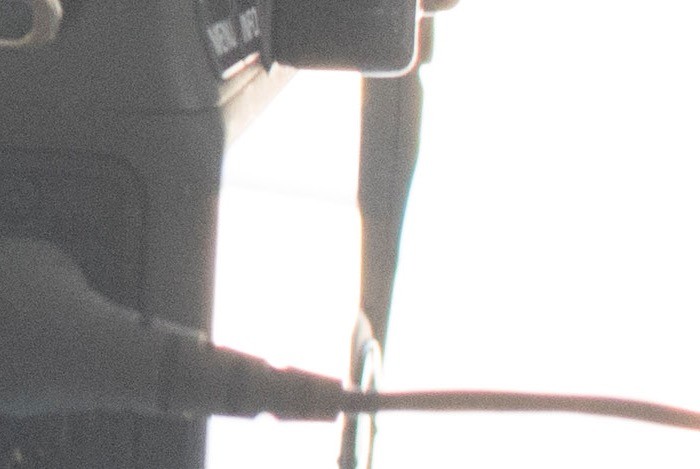
Sigma 30mm at f/5.6
For the sake of comparison, I snapped a few frames with other lenses. As you can see below, the Canon EF-S 24mm f/2.8 STM lens handles chromatic aberration much better wide open at f/2.8 than the Sigma 30mm does when stopped down 2 stops to equal the f/2.8 exposure.
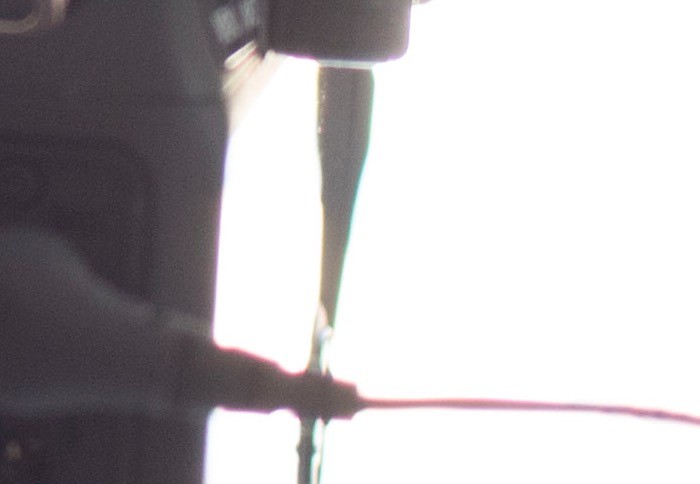
Canon EF-S 24mm at f/2.8
By f/4, the Canon EF-S 24mm STM lens is well under control.
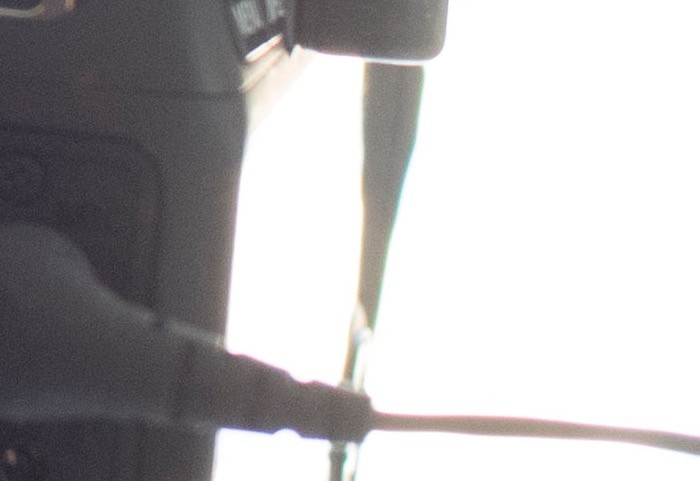
Canon EF-S 24mm at f/4
Below is the kit 18-135mm IS STM lens at f/4, which is the widest aperture at this focal length (around 30mm) and is close to the Sigma 30mm prime at f/4.
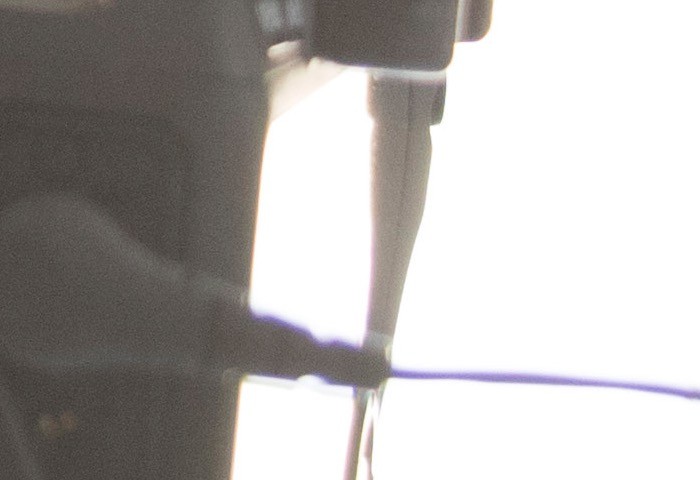
Canon 18-135mm IS STM at f/4
Aside from the chromatic aberration issues, I enjoy the flexibility and speed of the Sigma 30mm Art lens. I am fond of the 50mm focal length on full frame cameras, so it is a logical fit for my personal tastes. You will have to decide for yourself whether the occasional purple fringing is too big of a turnoff for you.
Canon EF-S 24mm f/2.8 STM Lens
I love the new move toward pancake lenses from Canon. I was quick to add the EF 40mm f/2.8 STM lens to my kit when it became available. And if Canon had released this 24mm lens as an EF mount instead of an EF-S mount, I would have jumped on it. That said, if you are shooting with a 7D Mark II, this is an easy lens to be sold on.
It is cheap at just $149 and works out to about a 38mm equivalent on a full frame field of view. As you can see, it’s pretty much the equivalent of the 40mm STM pancake lens on full frame Canon DSLRs.
When attached to the 7D Mark II, it makes the camera feel so much more compact thanks to the pancake styling and it is still reasonably fast with a f/2.8 max aperture. It has a seven blade diaphragm and the 7D Mark II’s Dual Pixel AF benefits from the STM focusing motor inside for smooth video focusing with mostly silent operation.
Canon EF-S 18-135mm f/3.5-5.6 IS STM Lens
This is a kit option for the 7D Mark II and a good choice to go with – particularly if you plan on doing any amount of video shooting. The combination of Image Stabilization and the STM focusing motor makes it a logical first lens for any 7D Mark II kit that will be used for video capture.

Canon EF-S 18-135mm IS STM Lens – ISO 1000
Additionally, as you can see in the AF performance notes above, the STM motor is competent at tracking fast moving subjects for the 7D Mark II’s high-performance AF system.
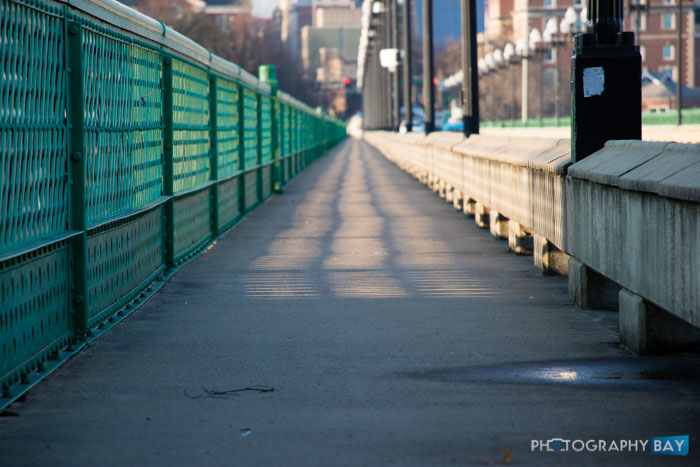
Canon EF-S 18-135mm IS STM Lens – ISO 250
The lens produces acceptable results; however, it is not going to be as sharp as some of the more expensive L lenses that the 7D Mark II is just begging to be paired with. That said, it is a solid kit lens and offers a versatile range for not much money.
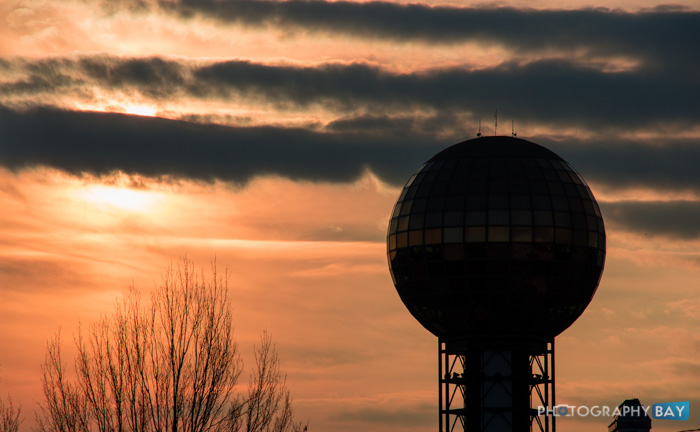
Canon EF-S 18-135mm IS STM Lens – ISO 100

Canon EF-S 18-135mm IS STM Lens – ISO 3200

Canon EF-S 18-135mm IS STM Lens – ISO 100

Canon EF-S 18-135mm IS STM Lens – ISO 1600

Canon EF-S 18-135mm IS STM Lens – ISO 100
Canon 7D Mark II Accessories
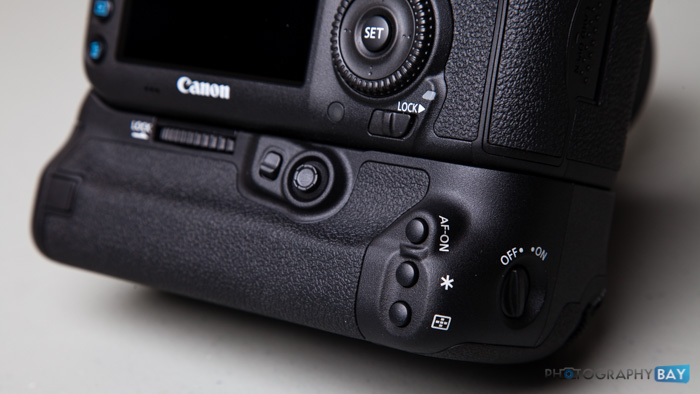
Fortunately, there is no remote to buy in order to be able to capture interval images for a timelapse; however, the Canon BG-E16 battery grip for the 7D Mark II is a worthwhile addition. It goes a step further in making the 7D Mark II look, feel and function like a truly professional camera.
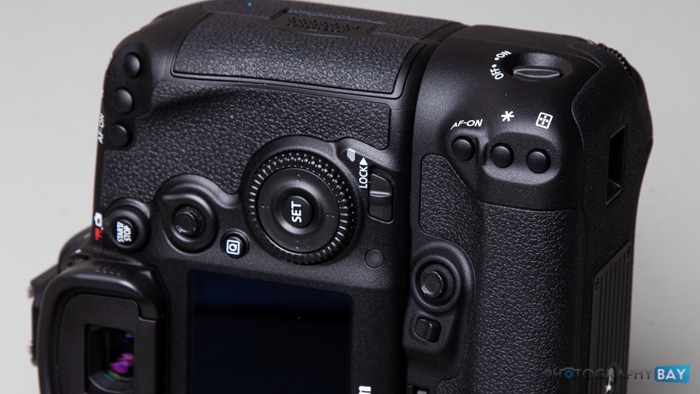
The ability to double the already-great battery life by adding another Canon LP-E6N battery or, in a pinch, use six AA batteries to power the camera is an added bonus to the ergonomic benefit of the vertical grip.
The 7D Mark II’s pop-up flash can act as a commander for multiple external Canon Speedlites, including the flagship 600EX-RT and lower-end 430EX II. This is one great argument for a pop-up flash and one of the few Canon DSLRs that offers this feature. It saves on both money and kit size.
As noted earlier, the 7D Mark II has two memory card slots – one CompactFlash slot and one SD card slot. It makes use of CF UDMA 7, which benefits from the fastest available cards today. Additionally, it offers UHS-I compatibility for SDHC and SDXC cards – something that the 5D Mark III sadly did not offer. Accordingly, using SD cards is perfectly acceptable in the 7D Mark II.
My suggestion would be to go with some fast SanDisk or Lexar CF cards for those who need high frame rates and quick buffer clearance. However, use SDXC UHS-I cards for video use since they are cheaper in larger capacities. SanDisk has several good options from which to choose.
Conclusion
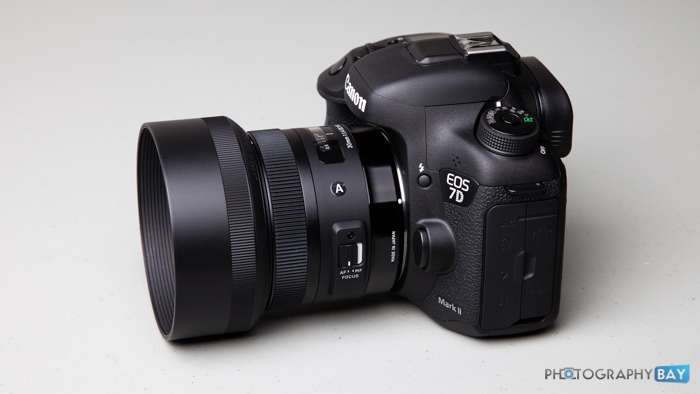
The Canon 7D Mark II is a fantastic DSLR. While it has some video shooting chops to it, the camera is first and foremost a sports- and wildlife-shooting beast.
The image quality improvements over the prior generation are better than expected. The AF system is state-of-the-art. The control and customization possible with this camera is more than you would expect for a $1800 asking price.
The spec sheet and feature highlights of the 7D Mark II can seem underwhelming at first glance. However, once you use this thing, you realize just how much is under the hood. I have to tip my hat to Canon for producing a solid, professional-grade camera at a very attractive price point.
As a sports and action camera, it is the best bang for your buck on the market. Nothing else comes close.
As an all-purpose DSLR, it is a strong offering that won’t slip up in just about any circumstance. Sure, there are cameras that offer more resolution or more video features; however, the 7D Mark II is very balanced from top to bottom.
Highly recommended.
The Canon 7D Mark II is available from Photography Bay’s trusted retail partner, B&H Photo, at the following links:
By making your photography purchases at B&H Photo through these links, you are helping Photography Bay to continue bring quality camera tests, news and reviews. Thanks for your continued support.
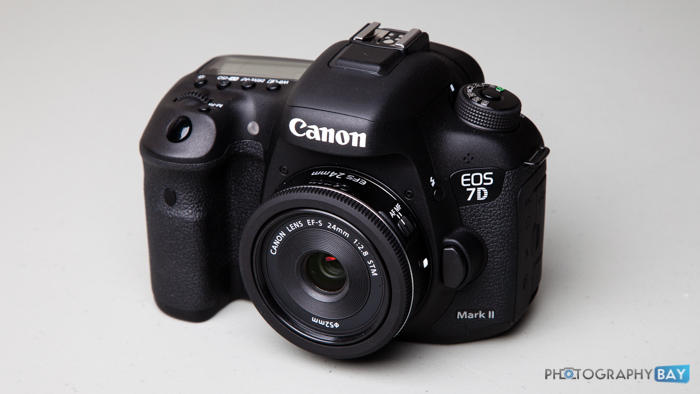
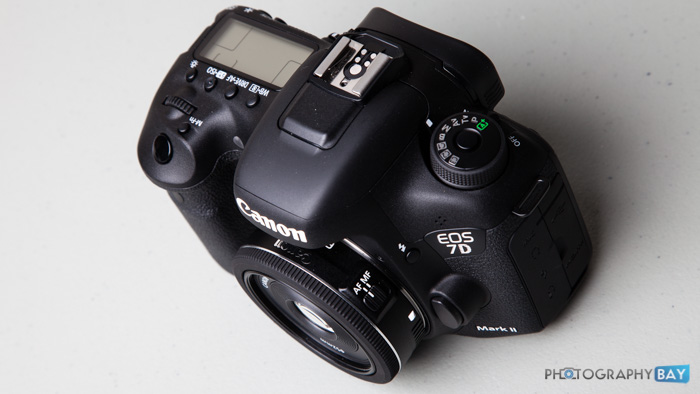
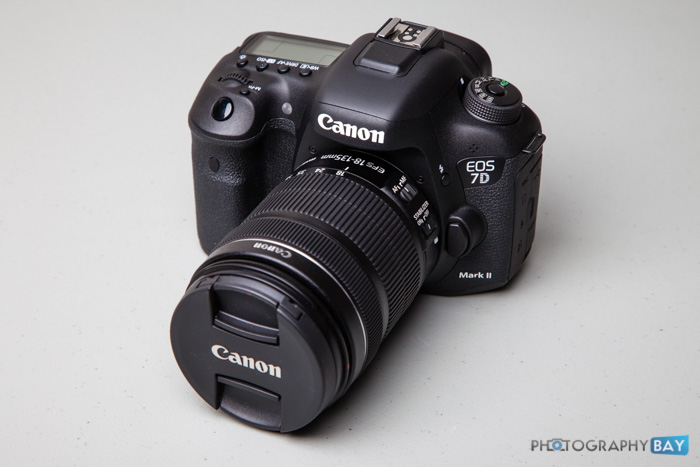


Great review. This might actually be a crop-sensor body worth picking up.
Does it have USB 3, like the 5Ds?
Yes sir, it does have USB3 together with a very sophisticated cable protector that makes it almost impossible to hurt the USB3 port! In case you decide to buy one, don’t forget to get a battery grip and a second battery ’cause with normal use it lasts about 400 shots with a lot of review and “on-screen playing around”.
I have both the 7D Mk2 and 5D Mk3 and what i have to say that no review mentions is that, 7D Mk2 noise cleans up much better between ISO 1600 and ISO 12800+ (especially in video, using Premiere Pro + Neat Video). By the end of the day, no matter how curious it sounds, i prefer the images and video shot with the 7D Mk2 over them shot with 5D Mk3!!!
Greetings from Greece.
All my best wishes.
Yiannis A.
Thanks! It’s hard to find pictures of the actual ports on the side of the camera.
B&H Photo shows the 5Ds with the port covers open, so you can see that it has USB 3.0, but I couldn’t find any similar images of the 7D Mk2.
http://static.bhphoto.com/images/multiple_images/images500x500/IMG_463527.jpg
I don’t do video, but I’m hoping USB 3.0 will help speed up tethered capture.
Overall I liked Eric’s Presentation on the 7DII. I’am wondering why he used 2 different lens on the 7DII and the 5DII for his comparisons of the 2 cameras and what were the lenses used? I have the 7DII and really would’ve liked to have seen the real differences between the two, as I was thinking of purchasing the 5DII just for portraits.
Sorry Larry. I was cold and not thinking. I’ve kicked myself for not using the 24-105mm L on both cameras for this. I was just trying to get it done quick and had a couple of other slip-ups and had to redo the comparison.
To your point, I still use the 5D Mark II on a regular basis. There’s nothing at all wrong with it at all for portraits. AF in low light can be a bit of a challenge compared to newer models, but it still works well enough.
This review (very welcome by the way) begs the question: do you think the 5D Mark IV (assuming they stick with this naming) will incorporate the 7D Mark II’s advances? Or put another way: will the newest 5D be principally a 7D Mark II with a full-frame sensor?
This Mark II sounds perfect for my desires (mostly wildlife and sports), but I’m thinking full frame is next on my to-do list.
Sorry I didn’t reply to this earlier.
Given what we see in the 5Ds models, I think a 5D Mark IV could lean more toward the big features in the 7D Mark II. That said, the 7D Mark II would be a solid choice for wildlife and sports.
Canon 7D Mark II review is awesome. Your honest review is welcomed.thanks
http://techspecie.com/
I’ve been shooting the Mk II since shortly after its release. I find it to be a big improvement over my 7D which I thought was great for a crop sensor. While they may be subtle, there are a lot of improvements with this version that you just have to try out yourself to really appreciate.
I too, was sorry that you didn’t get an opportunity to use the 24-105 mm F/4 L lens as I have found it to be my current walk-around lens choice. With the improvements in the ISO noise the F/4 hasn’t proved to be an impediment in even low light situations.
The camera has also shown itself to be very capable of taking some great photos even in the current high light levels of the “snowy” conditions here in NE, both through house windows & out on the waterfront.
One of my better moves!
jmk-nbsc